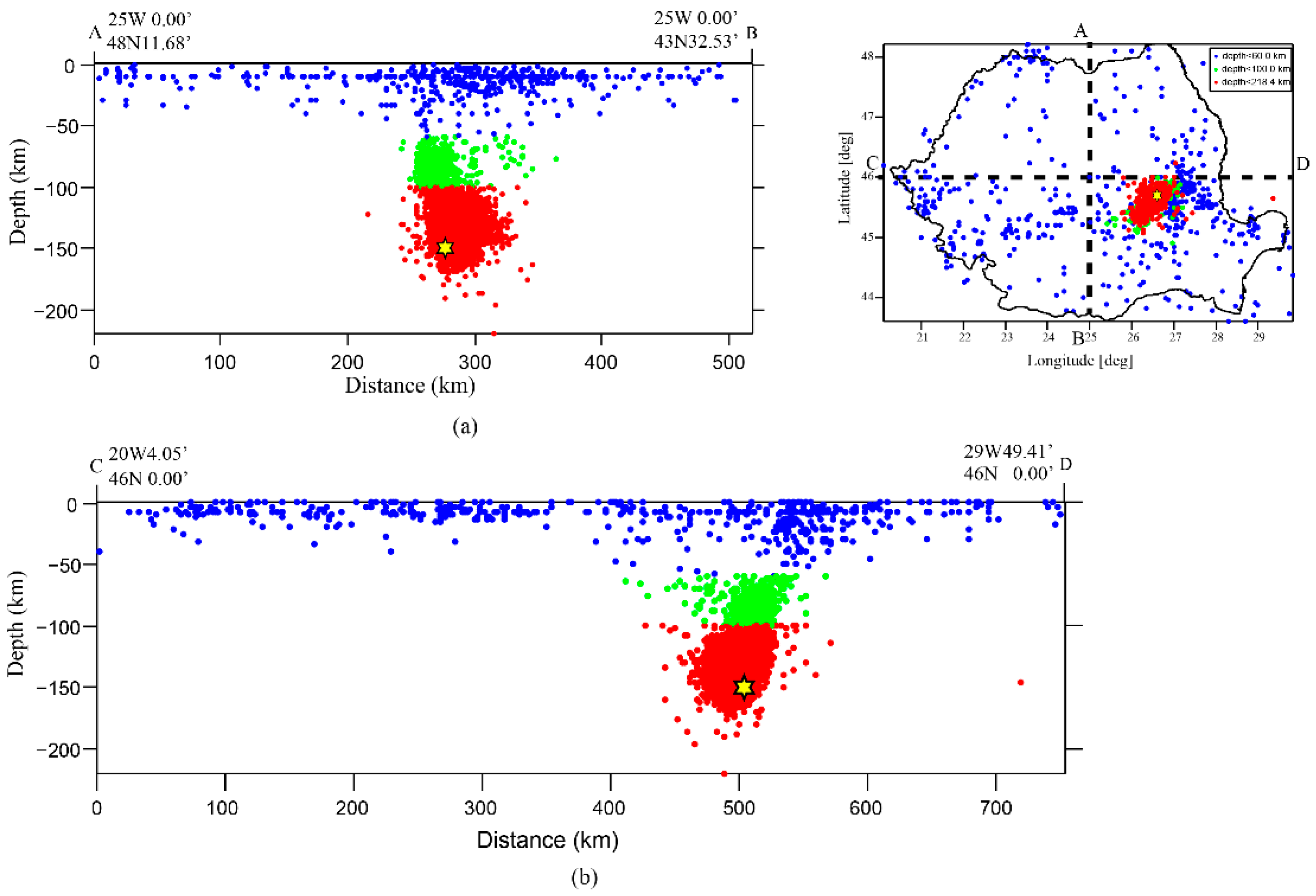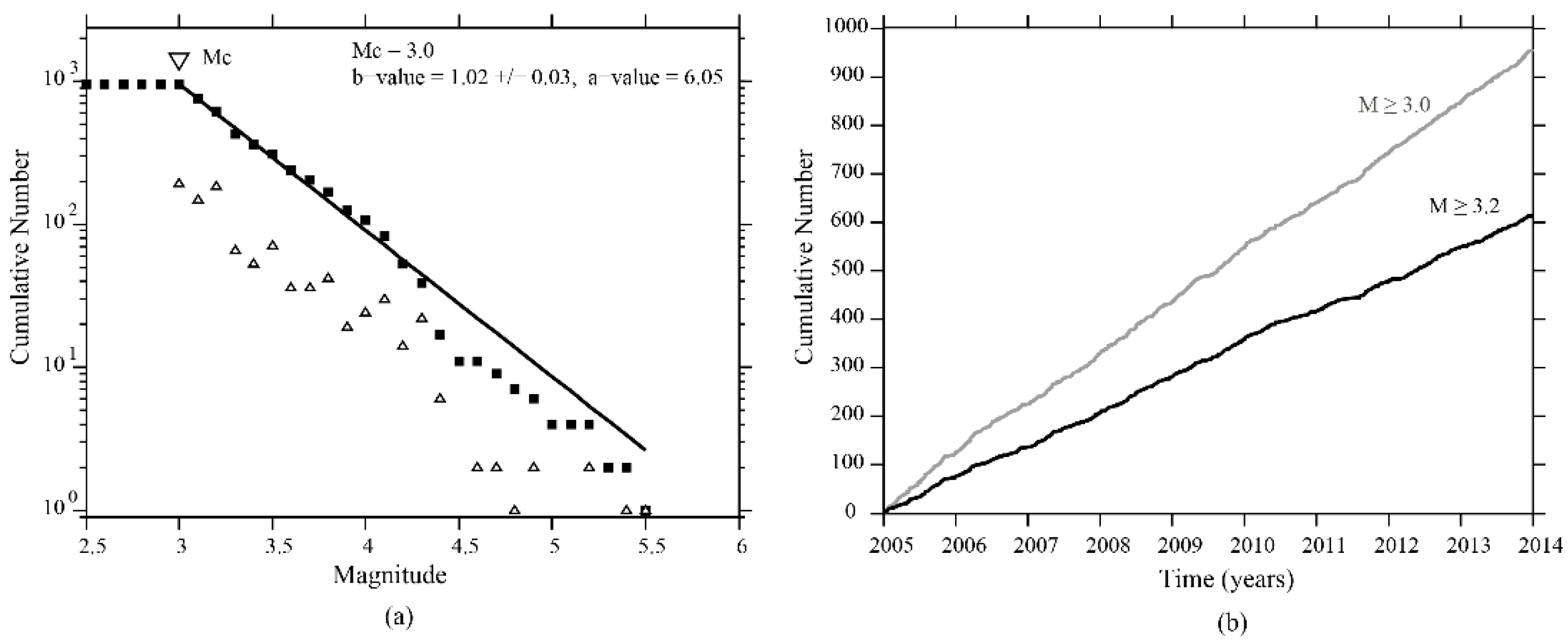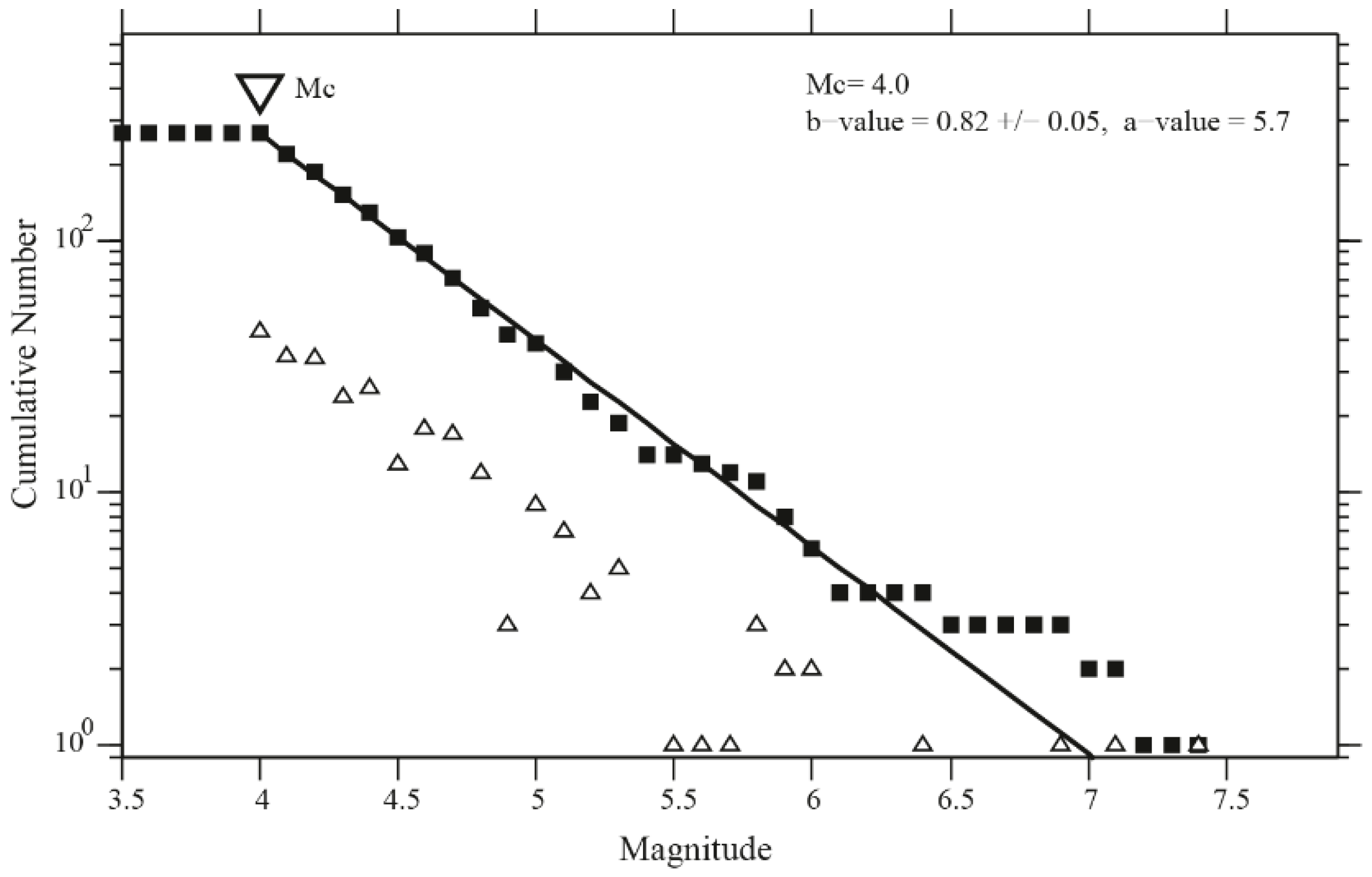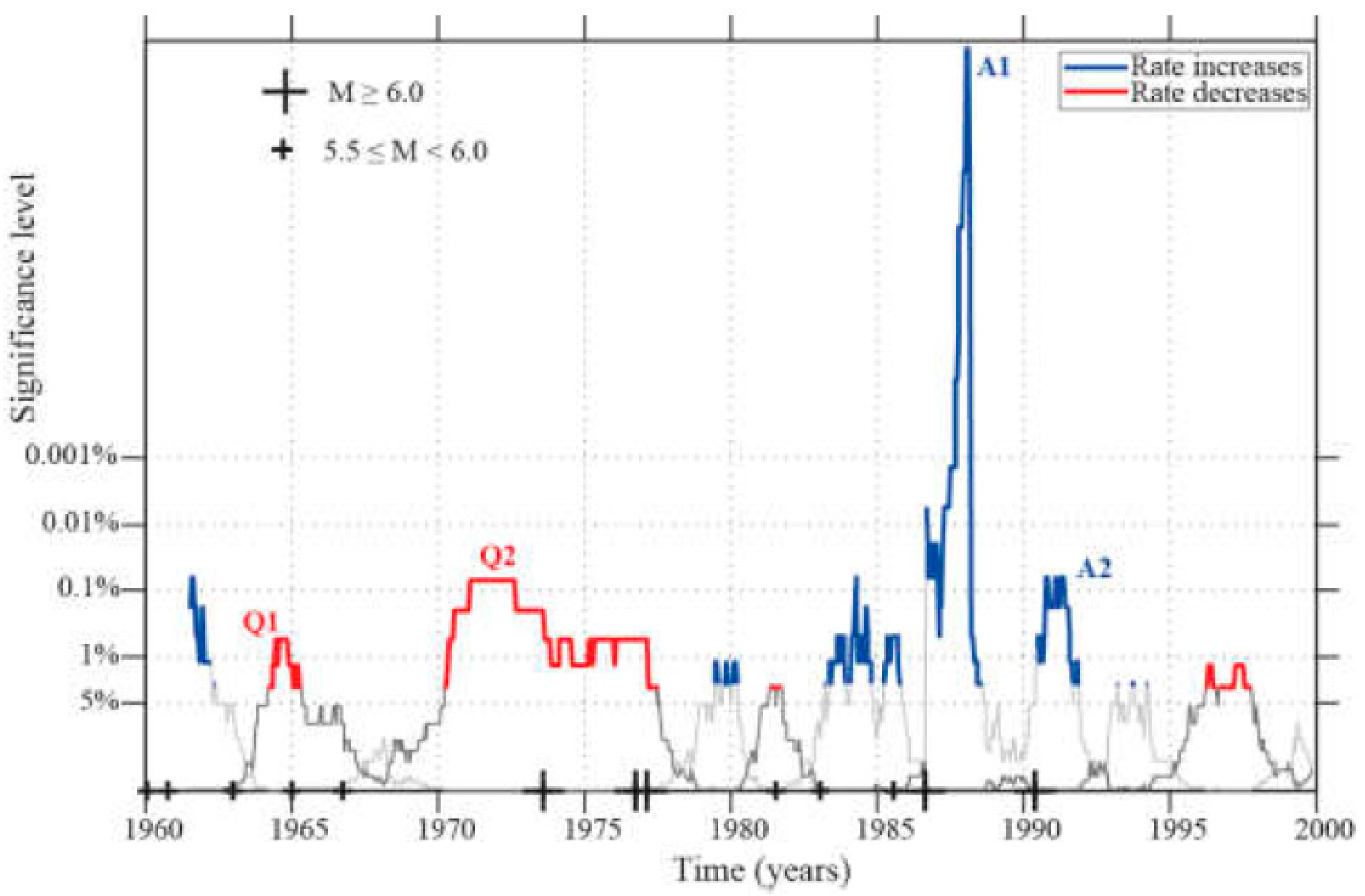Submitted:
15 May 2023
Posted:
16 May 2023
You are already at the latest version
Abstract
Keywords:
1. Introduction
2. Materials and Methods
2.1. Materials


2.2. Methods
3. Results
3.1. Some General Characteristics of Intermediate-Depth Seismicity



3.2. Checking for Seismicity Rate Changes for Vrancea Intermediate-Depth Earthquakes




4. Discussion
5. Conclusions
Author Contributions
Funding
Data Availability Statement
Acknowledgments
Conflicts of Interest
References
- Bala, A.; Raileanu, V.; Dinu, C.; Diaconescu, M. Crustal seismicity and active fault systems in Romania. Rom Rep Phys 2015, 67(3), 1176–1191.
- Roman, C. Seismicity in Romania - evidence for a sinking lithosphere. Nature 1970, 228, 1176-1178.
- Constantinescu, L.; Enescu, D. The Vrancea earthquakes in a scientific and technological framework; Romanian Academy: Bucharest, Romania, 1985, pp. 36 – 46 (in Romanian).
- Oncescu, M.C.; Marza, V.I.; Rizescu, M; Popa, M. The Romanian earthquake catalogue between 984 – 1997. In Vrancea Earthquakes: Tectonics, Hazard and Risk Mitigation; Wenzel, F., Lungu, D., Eds.; Kluwer Academic Publishers: Netherlands, 1999; 43 – 47.
- Jeffreys, I.L. Earthquakes and Mountains, Publisher: Methuen & Co, London, 1935.
- Trifu, C.-I.; Radulian, M. Asperity distribution and percolation as fundamentals of an earthquake cycle. Phys. Earth Planet. Inter. 1989, 58, 277 – 288. [CrossRef]
- Enescu, D.; Marza, V.; Zamarca, I. Contributions to the statistical prediction of Vrancea earthquakes. Rev. Roum. Geophys. 1974, 18, 67-79.
- Purcaru, G. Quasi- and supercyclicity of earthquakes and time-magnitude gaps in earthquake prediction. Tech. Rep. NORSAR Sci. Rep. 1974, 6-73/74, 53–55.
- Lungu, D.; Cornea, T.; Nedelcu, C. Hazard assessment and site-dependent response for Vrancea earthquakes. In Vrancea Earthquakes: Tectonics, Hazard and Risk Mitigation; Wenzel, F., Lungu, D., Eds.; Kluwer Academic Publishers: Netherlands, 1999, 43 – 47.
- Ismail-Zadeh, A.; Matenco, L.; Radulian, M.; Cloetingh, S.; Panza, G. Geodynamics and intermediate-depth seismicity in Vrancea (the south-eastern Carpathians): Current state-of-the art, Tectonophys. 2012, 530/531, 50 – 79, doi:10.1016/j.tecto.2012.01.016. [CrossRef]
- Knapp, J.H.; Knapp, C.C.; Raileanu, V; Matenco, L; Mocanu, V; Dinu C. Crustal constraints on the origin of mantle seismicity in the Vrancea Zone, Romania: the case for active continental lithospheric delamination. Tectonophysics 2005, 410(1–4), 311–323, doi:10.1016/j.tecto.2005.02.020. [CrossRef]
- Koulakov I.; Zaharia, B.; Enescu, B.; Radulian, M.; Popa, M.; Parolai, S.; Zschau, J. Delamination or slab detachment beneath Vrancea? New arguments from local earthquake tomography G-cubed 2010, 11(3), doi:10.1029/2009GC002811. [CrossRef]
- Ferrand, T.P.; Manea, E.F. Dehydration-induced earthquakes identified in a subducted oceanic slab beneath Vrancea, Romania. Sci Rep 2021, 11, doi:10.1038/s41598-021-89601-w. [CrossRef]
- Marza, V.I. A seismicity pattern of March 4, 1977 Vrancea, Romania earthquake: an earthquake prediction insight. Tectonophysics 1979, 57, 317-373. [CrossRef]
- Marza, V.I. The premonitory content of seismicity variations, manifestations at a global scale, with particularization for the Vrancea region. PhD, Bucharest University, 1981.
- Marza, V.I.; Burlacu, V.; Pantea, A.; Malita, Z. Case history of an anticipated event: the major (mw = 7.0, Mw = 7.2) Vrancea (Romania) earthquake of 1986 – revisited. Rev. Roum. Geophysique 2003, 47, 109 – 120.
- Radulian, M.; Trifu C.-I. Would it have been possible to predict the 30 August 1986 Vrancea earthquake? Bull. Seismol. Soc. Am. 1991, 81(6): 2498–2503, doi:10.1785/BSSA0810062498. [CrossRef]
- Bazacliu O.; Radulian M., Seismicity variations in depth and time in the Vrancea (Romania) subcrustal region. Natural Hazards 1999, 19, 165-177. [CrossRef]
- Mitrofan, H.; Chitea, F.; Anghelache, M.-A.; Visan, M. Possible triggered seismicity signatures associated with the Vrancea intermediate-depth strong earthquakes (southeast Carpathians, Romania). Seismol. Res. Lett. 2014, 85(2), 314–323, doi:10.1785/0220130045. [CrossRef]
- Gutenberg, B.; and Richter, C.F. Frequency of Earthquakes in California. Bull. Seismol. Soc. Am. 1944, 34, 185-188. [CrossRef]
- Popa, M.; Chircea, A.; Dinescu, R.; Neagoe, C.; Grecu, B.; Borleanu, F. Romanian earthquake catalogue (ROMPLUS), Mendeley Data 2022, V2, doi:10.17632/tdfb4fgghy.2. [CrossRef]
- Moldovan, I.A.; Popescu, E.; Constantin, A. Probabilistic seismic hazard assessment in Romania: application for crustal seismic active zones. Rom. Journ. Phys. 2008, 53(3-4), 575-591.
- Radulian M.; Bălă A.; Ardeleanu L.; Toma-Dănilă D.; Petrescu L.; Popescu E. Revised catalogue of earthquake mechanisms for the events occurred in Romania until the end of twentieth century: REFMC. Acta Geod Geophys 2019, 54(1), 3- 18. [CrossRef]
- Oros E.; Plăcintă A. O.; Moldovan I. A. The analysis of earthquakes sequence generated in the Southern Carpathians, Orsova June-July 2020 (Romania): Seismotectonic implications, Rom. Rep. Phys. 2021, 73, 706.
- Enescu B.; Moldovan I.; Radulian M.; Ghita C.; Borleanu F.; Placinta A.O.; Poiata N. Seismicity analysis for Vrancea region (Romania) using a z-value statistical approach. In Proceedings of the 3rd European Conference on Earthquake Seismology and Engineering, Bucharest, Romania, September 4-9, 2022.
- Aki, K. Maximum likelihood estimate of b in the formula log N=a-Bm and its confidence limits. Bull. Earthq. Res. Inst., 1965, 43, 237-239.
- Utsu, T. A method for determining the value of b in a formula log n=a-bM showing the magnitude-frequency relation for earthquakes. Geophys. Bull. Hokkaido Univ. 1965, 13, 99-103 (in Japanese with English summary).
- Shi, Y.; Bolt, B.A. The standard error of the magnitude-frequency b value. Bull. Seismol. Soc. Am. 1982, 72(5), 1677–1687, doi:10.1785/BSSA0720051677. [CrossRef]
- Wiemer, S.; Wyss, M. Minimum Magnitude of Completeness in Earthquake Catalogs: Examples from Alaska, the Western United States, and Japan. Bull. Seismol. Soc. Am. 2000, 90(4), 859–869, doi:10.1785/0119990114. [CrossRef]
- Wiemer, S. A Software Package to Analyze Seismicity: ZMAP. Seismol. Res. Lett. 2001, 72, 373-382, doi:10.1785/gssrl.72.3.373. [CrossRef]
- Matthews, M.V.; Reasenberg, P.A. Statistical methods for investigating quiescence and other temporal seismicity patterns. PAGEOPH 1988, 126, 357–372, doi:10.1007/BF00879003. [CrossRef]
- Reasenberg, P.A.; Simpson, R.W. Response of regional seismicity to the static stress change produced by the Loma Prieta earthquake. Science 1992, 255, 1687 – 1690, doi:10.1126/science.255.5052.1687. [CrossRef]
- Wiemer, S.; Wyss, M. Seismic quiescence before the landers (M = 7.5) and big bear (M = 6.5) 1992 earthquakes. Bull. Seismol. Soc. Am. 1994, 84(3), 900–916, doi:10.1785/BSSA0840030900. [CrossRef]
- Enescu, B.; Struzik, Z.; Kiyono, K. On the recurrence time of earthquakes: insight from Vrancea (Romania) intermediate-depth events, Geophys. J. Int. 2008, 172(1), 395–404, doi:10.1111/j.1365-246X.2007.03664.x. [CrossRef]
- Telesca, L.; Alcaz, V.; Burtiev, R.; Sandu, I., Time-clustering analysis of the 1978–2008 sub-crustal seismicity of Vrancea region. Nat. Hazards Earth Syst. Sci. 2011, 11, 2335–2340, doi:10.5194/nhess-11-2335-2011. [CrossRef]
- Frohlich, C. Deep Earthquakes; Cambridge University Press, Cambridge, UK, 2006, doi:10.1017/CBO9781107297562. [CrossRef]
- Prieto, G.A.; Beroza, G.C.; Barrett, S.A.; López, G.A.; Florez, M. Earthquake nests as natural laboratories for the study of intermediate-depth earthquake mechanics, Tectonophysics 2005, 570/571, 42-56, doi:10.1016/j.tecto.2012.07.019. [CrossRef]
- Trifu, C.-I.; Radulian, M. Frequency-magnitude distribution of earthquakes in Vrancea: Relevance for a discrete model. J. Geophys. Res. 1991, 96(B3), 4301– 4311, doi:10.1029/90JB02221. [CrossRef]
- Enescu, B.; Ito, K. Precursory phenomena of seismicity in Vrancea region, Romania. Annuals of Disas. Prev. Res. Inst., Kyoto University 1999, 42(B-1), 113-123.
- Scholz, C. H. On the stress dependence of the earthquake b value. Geophys. Res. Lett. 2015, 42, 1399– 1402. doi:10.1002/2014GL062863. [CrossRef]
- Tormann, T.; Enescu, B.; Woessner, J.; Wiemer, S. Randomness of megathrust earthquakes implied by rapid stress recovery after the Japan earthquake. Nat Geosci 2015, 8(2):152–158. https://doi.org/10.1038/ngeo2343. [CrossRef]
- Frohlich, C.; Davis, S. Teleseismic b-values: or much ado about 1.0. J. Geophys. Res. 1993, 98(B1), 631–644, doi:10.1029/92JB01891. [CrossRef]
- Rogozea, M.; Enescu B.; Bazacliu, O.; Popa, M.; Radulian, M. Seismicity characteristics in the particular case of Vrancea (Romania) intermediate-depth earthquakes. In Proceedings of the CRC-461 International Symposium on Strong Vrancea Earthquakes and Risk Mitigation, MATRIX ROM, Bucharest, p. 156-160, 2007.
- Radulian M.; Popa M. Scaling of the source parameters for the Vrancea intermediate depth earthquakes, Tectonophysics 1996, 261, 67-81, doi:10.1016/0040-1951(96)00057-1. [CrossRef]
- Hurukawa, N.; Imoto, M. Periodic upward migration model for intermediate-depth earthquakes in Vrancea, Romania. Earth Planet Sp 2010, 62, 463–473, doi:10.5047/eps.2010.02.007. [CrossRef]
- Koch, M. Seismicity and structural investigations of the Romanian Vrancea region: evidence for azimuthal variations of P-wave velocity and Poisson’s ratio. Tectonophysics 1982, 90, 91 – 115. [CrossRef]
Disclaimer/Publisher’s Note: The statements, opinions and data contained in all publications are solely those of the individual author(s) and contributor(s) and not of MDPI and/or the editor(s). MDPI and/or the editor(s) disclaim responsibility for any injury to people or property resulting from any ideas, methods, instructions or products referred to in the content. |
© 2023 by the authors. Licensee MDPI, Basel, Switzerland. This article is an open access article distributed under the terms and conditions of the Creative Commons Attribution (CC BY) license (http://creativecommons.org/licenses/by/4.0/).




